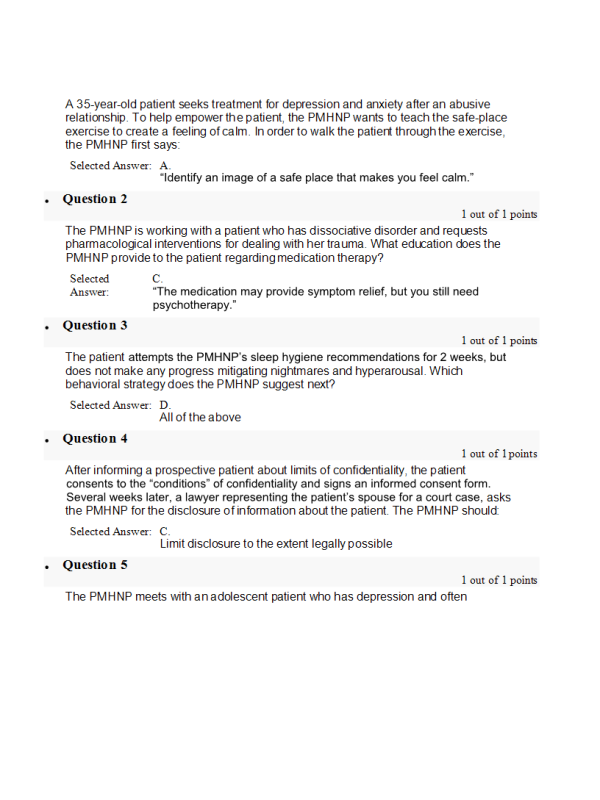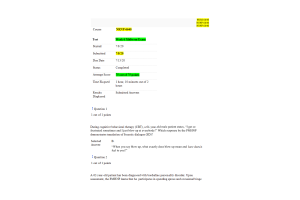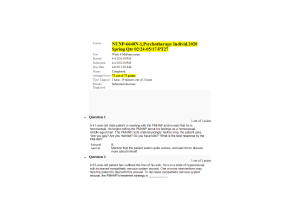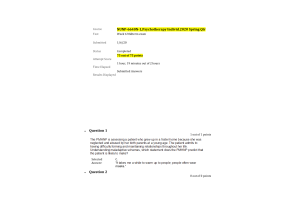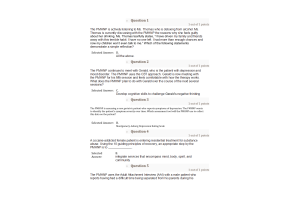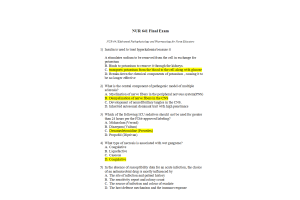NURS 6640 Week 6 Midterm ExamSpring Term
- $39.00
- Question: A 35-year-old patient seeks treatment for depression and anxiety after an abusive relationship. To help empower the patient, the PMHNP wants to teach the safe-place exercise to create a feeling of calm. In order to walk the patient through the exercise, the PMHNP first says:
- Question: The PMHNP is working with a patient who has dissociative disorder and requests pharmacological interventions for dealing with her trauma. What education does the PMHNP provide to the patient regarding medication therapy?
- Question: The patient attempts the PMHNP’s sleep hygiene recommendations for 2 weeks, but does not make any progress mitigating nightmares and hyperarousal. Which behavioral strategy does the PMHNP suggest next?
- Question: After informing a prospective patient about limits of confidentiality, the patient consents to the “conditions” of confidentiality and signs an informed consent form. Several weeks later, a lawyer representing the patient’s spouse for a court case, asks the PMHNP for the disclosure of information about the patient. The PMHNP should:
- Question: The PMHNP meets with an adolescent patient who has depression and often
presents with resistance when discussing his parent’s divorce. For the past couple of sessions, the patient has been quiet, sometimes refusing to speak. To further support the therapeutic relationship, the PMNHP:
- Question: The PMHNP employs psychodynamic psychotherapy with a patient who experiences anxiety and depression. As the process enters the psychoanalytic end of the psychodynamic continuum, the PMNHP will focus on:
- Question: The PMHNP is working with a patient who witnessed her father pass away after suffering for several months from terminal cancer. The PMHNP sees this as a traumatic event. The patient reports sometimes feeling out of touch with surroundings; almost as if things feel like a dream. “Sometimes that sensation lingers for a while,” the patient says, “and other times I snap out of it quickly.” What does the PMHNP infer about the condition based on psychotherapy concepts for trauma?
- Question: The PMHNP is working with a school-aged child who has been diagnosed with depression. The child has attended several sessions with the PMNHP, but recently presents with avoidant behavior by showing increased distress and being late to sessions. What approach does the PMHNP need to employ with the child to continue making therapeutic progress?
- Question: An 11-year-old patient has been exhibiting low self-esteem at school and acting out. According to Maslow’s hierarchy of needs, which of the following questions would best be addressed first by the PMHNP?
- Question: The PMHNP is working with a patient who experiences anxiety around her parents that later leads to poor impulse control. What will the PMHNP do to employ psychodynamic psychotherapy properly for this patient?
- Question: The patient is a 56-year-old female patient diagnosed with panic disorder and reports symptoms that include heart palpitations, frequent trembling, and feelings of choking in stressful situations. What special consideration does the PMHNP make?
- Question: The PMHNP is working with a veteran who has posttraumatic stress disorder (PTSD). The PMHNP believes that dual awareness will be beneficial in allowing the patient to focus on the here and now. What strategies can the PMHNP use to develop dual awareness in the patient?
- Question: The PMHNP has been treating a 15-year-old patient with a history of abuse and neglect. Thirty minutes into their therapy session the patient jumps up and begins to pace around the room. Utilizing Socratic dialogue (SD) the PMHNP’s best action would be to:
- Question: The PMHNP is caring for a patient with borderline personality disorder. Using a psychoanalytic psychotherapy approach, the PMHNP attempts to intensify the patient’s transference to enhance emotional processing by:
- Question: When completing this exam, did you comply with Walden University’s Code of Conduct including the expectations for academic integrity?
- Question: An initial evaluation reveals that an 11-year-old patient has moved to a new school after her parents’ recent divorce, and is having trouble making friends. The patient has normal mental status and exhibits appropriate behavior. What is the most appropriate scale for the PMHNP to use to get more information?
- Question: A PMHNP is treating a 50-year-old patient who suffers from depression. When he was growing up, he was often responsible for taking care of his three younger siblings. Since then, the patient puts other people’s needs before his own. Based on this information, the PMHNP would conclude that his interpersonal style is .
- Question: The PMHNP is assessing a patient who grew up in a foster home because she was neglected and abused by her birth parents at a young age. The patient admits to having difficulty forming and maintaining relationships throughout her life. Understanding maladaptive schemas, which statement does the PMHNP predict that the patient is likely to make?
- Question: A 28-year-old male patient is experiencing distress related to the workplace. What might the PMHNP ask to assess affective development?
- Question: The PMHNP is meeting with a new patient who is a young veteran back from serving two tours overseas. When reviewing the patient’s health history file that was sent from the VA, the PMHNP learns that several months ago, the patient was diagnosed with PTSD, but never followed up with treatment for it. After a comprehensive mental health assessment, the PMHNP confirms the PTSD diagnosis and understands thatwhich therapeutic approach will be the most effective as a first-line treatment modality?
- Question: A 65-year-old patient has suffered the loss of his wife. He is in a state of hyperarousal with increased sympathetic nervous system arousal. One or more interventions may help the patient to deal with this arousal. To decrease sympathetic nervous system arousal, the PMHNP’s treatment strategy is .
- Question: The PMHNP is treating a patient with a substantial fear of feeling closed in (claustrophobia). Thus, the patient will not get into an elevator. The office where he works is on the 10th floor and this requires that he walk up and down the stairs in the morning and evening to get to his office. With permission from the patient, the PMHNP is beginning systematic desensitization to address the patient’s need to use the elevator. What is the PMHNP’s best plan of action?
- Question: The PMHNP has a session with a patient who was injured and traumatized from an explosion at the industrial plant where he used to work. During the session, an outside noise startles the patient and he experiences a flashback of theloud boom from the explosion. The PMHNP witnesses the patient present with anxiety and belabored breathing. What is the appropriate action of the PMHNP?
- Question: When the patient comes into the office, she says, “I just saw a friend of mine out in the waiting room. What’s wrong with him?” The PMHNP says, “He’ll be fine. He has mild depression.” Which of the following statement is correct related to confidentiality rights?
- Question: You are seeing a 29-year-old widow whose husband recently died overseas while serving his country in the military. She has been mourning the loss of her husband for several months, and continues to grieve. She refuses to go to group grieving sessions, but reports that she is still able to go to work and her fitness classes sometimes, and even makes attempts to stay social. She says, “Sometimes it’s like he’s not even gone. Other times it feels like it’s been an eternity since I’ve seen him.
It’s hard to talk about this type of stuff with my girlfriends, especially since all of their husbands are still alive.” The PMHNP understands that it is appropriate to employ which therapeutic principle?
- Question: A PMHNP is caring for a 21-year-old woman who is suffering from anxiety and is having difficulty managing stress. Which of the following would be an appropriate step by the PMHNP?
- Question: The PMHNP is working with an adult patient who has somatic complaints caused by a history of childhood abuse. As part of the therapeutic process, what does the PMHNP do to assess and organize a trauma history?
The PMHNP meets with a 47-year-old male patient who is fearful of leaving the
- Question: house after having witnessed his neighbor getting run over by a car. When the PMHNP asks why he is afraid to leave his house, the patient replies, “Because another accident might occur.” Which cognitive behavioral therapy (CBT) strategy does the PMHNP employ?
- Question: The PMHNP is working with a patient who seems dissatisfied with the therapeutic relationship. The PMHNP invites the patient to discuss her feelings regarding the PMHNP openly and honestly. It becomes clear to the PMHNP that they are experiencing an alliance rupture. How does the PMHNP repair the therapeutic alliance?
- 30. Question: Your patient is a 65-year-old male who has a strained relationship with his son and daughter. His children refuse to participate in a family session. The PMHNP asks the patient to draw his family genogram as a next step to .
- Question: The PMHNP is meeting with a 38-year-old divorced, single mother who has been seeing the PMHNP for anxiety and anger management. During one of the sessions, the patient tells the PMHNP that she is having a problem getting her child support payments from her ex-husband, which is triggering increased anxiety and anger, which she admittedly takes out on her children. How does the PMHNP respond in a way that upholds the supportive psychodynamic psychotherapy approach?
- Question: The PMHNP is caring for a patient with dissociated self-state that the PMHNPidentifies as being associated with traumatic experiences in the patient’s past. What approach does the PMHNP use with the patient that is crucial to the psychodynamic therapy process?
- Question: When a PMHNP is seeing a patient for the first time, what is an important step to assure that the patient and provider understand the limits of their discussion?
- Question: The PMHNP understands that anxiety and depression are two disorders in which their symptoms may overlap. When discussing this, you explain that the autonomic nervous system is activated and further helps distinguish anxiety symptoms by making the following points:
- Question: A PMHNP is preparing confidentiality forms for his patients. What is the most appropriate first step he should take?
- 36. Question: A PMHNP has been working with a young female patient who suffers from depression to change self-defeating behaviors. By creating a presence of acceptance and using good listening skills, the PMHNP’s overall goal is to .
- Question: The PMHNP is meeting with a 42-year-old man with depression brought on by the recent passing of his wife. As he describes the circumstances surrounding his late wife’s death, the PMHNP begins to feel sad. The sadness lingers for several hours, and the PMHNP finds it difficult to focus on other patients for the rest of the day. What is the most appropriate explanation for the reaction that the PMHNP is experiencing?
- Question: A 24-year-old female patient presents for her initial appointment with the PMHNP. Which action will the PMHNP take to establish therapeutic alliance?
- Question: A PMHNP is treating a 45-year-old female patient who is upset that her brother has not been calling since his divorce. When asked to describe her brother and what prompts him not to call as frequently, she says, “Everything is about him, not me. I think he’s jealous that I have a good marriage and he wants me to be unhappy, too. So he doesn’t call to upset me and ruin my relationships.” Based on this information, the PMHNP can conclude that the patient .
- Question: The PMHNP is working with a 56-year-old man who is being seen because of his anxiety and depression. During the therapy sessions, the PMHNP assists the patient in discussing his experiences and expanding on his thoughts and feelings. He tells the PMHNP stories about how he used to be teased by his coworkers at the office for becoming too anxious in large conference rooms. The PMHNP listens to the patient and helps focus on his strengths to promote self-understanding. Which principle best accounts for the PMHNP’s interactions with the patient?
- Question: During cognitive behavioral therapy (CBT), a 64-year-old male patient, states, “My wife hates me! She’s just waiting for me to die.” Using Socratic dialogue (SD) the PMHNP demonstrates understanding of analysis when she responds:
- Question: A PMHNP is taking a history and wants to assess how the patient copes with adversity. To do so, the therapist asks questions about the patient’s belief system.
What would be an appropriate question to ask?
- Question: A patient named Steve is seeking therapy to get help with his home situation, stating that he has been stressed since his mother-in-law moved into the house. What can the PMHNP do to assist the patient in constructing a narrative?
- Question: The PMHNP is having a therapy session with Charlotte, a 20-year-old victim of date rape. The patient states, “I shouldn’t have been there; I should have just gone home. This was all my fault; how could I have been so stupid?” Using the Socratic method, what is the PMHNP’s best response?
- Question: At the initial interview with a patient, the PMHNP reviews the condition of receiving services, including limits that will be imposed on confidentiality. During the discussion, the patient shares information that the PMHNP is legally required to report.
True or false: If the PMHNP does not report information that s/he is legally required to report, state laws govern the consequences which include penalties for not reporting, especially child and elder abuse.
- Question: In your office, you see a 58-year-old patient with PTSD who reports having nightmares, making it impossible for her to sleep. What recommendations based on principles of sleep hygiene will the PMHNP make?
- Question: A new patient has been informed of the limits of confidentiality, and has signedinformed consent forms. No consent, however, has been obtained for voluntary “Release of Information.” The patient is 20 years old and still lives at home with his parents. He is being treated for depression, which he attributes to the trouble he’s had finding employment.True or false: If the patient’s mother calls the PMHNP to check up on her son to see how he is doing, the therapist is required to protect patient confidentiality and not disclose information.
- Question: The PMHNP is caring for a patient who seems to seek affection and attention from the PMHNP and others in the clinic, as well as displays heightened emotional responses to feelings of being excluded. What therapeutic approach does the PMHNP use to decrease autonomic arousal in the patient?
- Question: The PMHNP is mentoring a student. After working with a patient during a session, the student laments about all the things she should have, or could have, said to the patient. “I feel guilty that I didn’t speak up more about the patient’s concern toward her son,” says the student. The PMHNP understands that the student is exhibiting signs of which therapeutic concept?
- Question: The PMHNP is working with a patient who is living in poverty and abusing substances. According to the treatment hierarchy framework, what needs does the PMHNP need to attend to first?
- Question: A PMHNP’s patients have already signed confidentiality agreements, including limits that will be imposed on confidentiality. Months later, the state’s laws have changed that affect confidentiality promises the PMHNP has already made. What is an appropriate step for the PMHNP to take after finding out this information?
- Question: A 41-year-old male patient is meeting with the PMHNP and reveals that he is homosexual. He begins telling the PMHNP about his feelings as a homosexual, middle-aged man. The PMHNP nods understandingly. Before long, the patient asks, “Are you gay? Are you married? Do you have kids?” What is the best response by the PMHNP?
- Question: The PMHNP is working with a 43-year-old male patient who develops idiosyncratic transference over weeks of therapy. The best way for the PMHNP to respond to this patient is to:
- Question: A patient who has borderline personality disorder is meeting with the PMHNP. When asked about future goals, the patient responds, “I’d like to go back to school to do what youdo. You know, talk to people all day about their problems. It seems pretty easy.” How does the PHMNP respond to the client in a way that is free from any stigmatizing beliefs or judgments?
- Question: The PMHNP is caring for a patient who has acute stress disorder after experiencing a traumatic event 1 week prior. The PMHNP wants to begin with a therapeutic framework that follows the adaptive information processing (AIP) model. What is the priority action for the PMHNP to take?
- Question: The PMHNP is working with a patient who experiences abreactions when discussing repressed feelings of his sexual abuse as a child. What can the PMHNP do to manage the patient’s intense emotional reactions?
- Question: The PMHNP is caring for a patient who the PMHNP believes would benefit from a relational psychodynamic approach to therapy. Which action made by the PMHNP demonstrates appropriate use and understanding of the relationship psychodynamic model?
- Question: A PMHNP is assessing ego functioning of his 40-year-old patient by asking what she feels is the cause of her problems. She attributes her problems to her overprotective parents not letting her have enough freedom growing up. Based on her answer, the PMHNP is testing
- Question: During a therapy session the patient is asked how she currently deals with stress, and she says, “Well, I don’t. I just let it build and build.” The PMHNP responds by asking how well this has been working out for her. The patient states, “Well, to be honest, it just feels like I’m drowning, you know what I mean.” Illustrating idiosyncratic meaning, the PMHNP responds with:
- Question: A middle-aged man who works over 50 hours a week is being seen for depression and anger management. He states, “I am even more frustrated when I come home and my wife wants to argue about stupid stuff. All I want to do is come home, take a shower, and eat. Is that too much to ask?” The PMHNP explains that people can be assertive, aggressive, and passive. She encourages the patient to be more assertive and begins role-play with assertive training. The PMHNP determines that the patient is beginning to understand when he states:
- Question: A 62-year-old patient has been diagnosed with borderline personality disorder. Upon assessment, the PMHNP learns that he participates in spending sprees and occasional binge eating, accompanied by rapid changes in self- image. Which evidence-based psychotherapeutic model does the PMHNP identify as effective and beneficial?
- Question: A PMHNP may ask his patient to describe her relationship with her father, both as a child and now, in order to assess interpersonal style.
- Question: A 35-year-old patient has been seeking treatment for depression for several months. The PMHNP does an assessment to see if processing has led to adaptive change. The patient’s self-references are positive in relation to past events, work is productive, relationships are adaptive, and there is congruence between behavior, thoughts, and affect. Based on this information, the PMHNP decides the patient
- Question: The PMHNP has been assisting a shy and timid 23-year-old male patient struggling with esteem and self-concept issues. Over the weekend, this patient was given the task of completing an exercise that would usually cause him distress and shame, also called a shame-attacking exercise. The PMHNP determines that this task has successfully been achieved when the patient states:
- Question: One of the strategies the PMHNP wants to try includes sleep restriction. What will the PMHNP suggest to follow sleep restriction therapy?
- Question: During cognitive behavioral therapy (CBT), a 64-year-old male patient states, “I get so frustrated sometimes and I just blow up at everybody!” Which response by the PMHNP demonstrates translation of Socratic dialogue (SD)?
- Question: During a session, the PMHNP asks a patient with a history of sexual abuse to recall the relationship she had as a child with her parents. The patient responds by saying she has a headache and her stomach hurts, and starts talking about her physical ailments. What is the appropriate response by the PMHNP?
- Question: The PMHNP is working with a patient who has insomnia and battles going to sleep. The patient reports consistent self-defeating behaviors, and hates trying to go to sleep. Which action made by the PMHNP demonstrates the use of a paradoxical intervention?
- Question: An appropriate response that the PMHNP might tell the patient is, “I understand that you are upset. [Summarizes diagnosis, treatment recommendations, and follow-up plan.] We can continue the conversation next week. How does this time next Monday work for you?”
- Question: A 16-year-old female patient has had a stable therapeutic relationship with the PMHNP for several months. The PMHNP notices what appears to be fresh cigarette burns on the patient’s arm. When asked, the patient admits to this self-injurious behavior. Although the patient is still depressed, her mood seems to be somewhat better this week. True or false: The PMHNP would most likely consider this patient stabilized and ready to move to Stage II.
- Question: The PMHNP is treating a 35-year-old male officer in the military. He discloses that both of his parents are deceased and that he loved them. However, he says that he had feelings of inadequacy because his parents held him to a standard that he could never achieve. He went on to say that nothing he did ever felt good enough. The PMHNP assesses that this patient has perfect creases in his uniform with no strings or tags out of place; she also notices that he has perfect posture and questions him about ritualistic behaviors. She suspects that this patient has maladaptive responses to the expectations placed on him as a teenager and young adult. Which statements made by the patient would verify the PMHNP’s suspicion?
- Question: During a clinical assessment of a 15-year-old patient, the PMHNP asks, “How can I help you?” The patient answers by saying, “Honestly, I don’t really think I need any help.” Which of the following is the most appropriate response by the PMHNP?
- Question: During a therapy session with an 18-year-old female the PMHNP learns that she has lived in six different foster homes in the last 24 months. She states that her mother is in a correctional facility for drug abuse and prostitution. During the assessment, the PMHNP notices multiple superficial cuts to each wrist. The patient appears tearful, withdrawn, and never makes direct eye contact. The PMHNP believes that this patient may have feelings of insecurities as well as abandonment issues and is aware that which diagnosis is likely possible?
- Question: The PMHNP is conducting a peer review of another PMHNP’s medical charts. Upon review, the PMHNP notes that the peer often begins patient sessions late, as well as ends them later than scheduled. The PMHNP also found a comment in the chart regarding the patient sending text messages while in the middle of the session.
Based on these findings, the feedback that the PMHNP will provide to the peer involves which therapeutic principle?
- Question: The PMHNP is mentoring a student. After working with a patient during a session, the student laments about all the things she should have, or could have, said to the patient. “I feel guilty that I didn’t speak up more about the patient’s concern toward her son,” says the student. The PMHNP understands that the student is exhibiting signs of which therapeutic concept?
